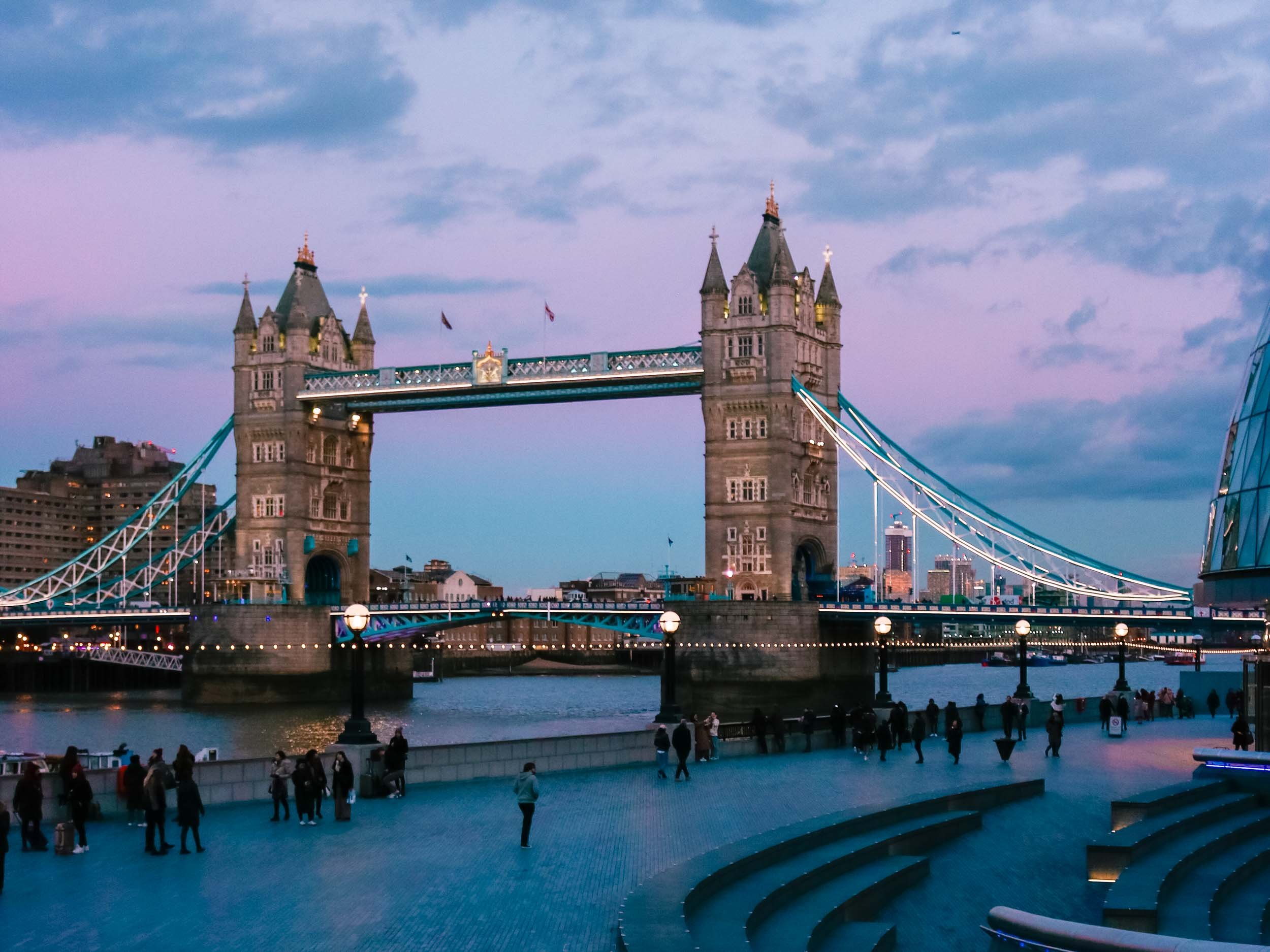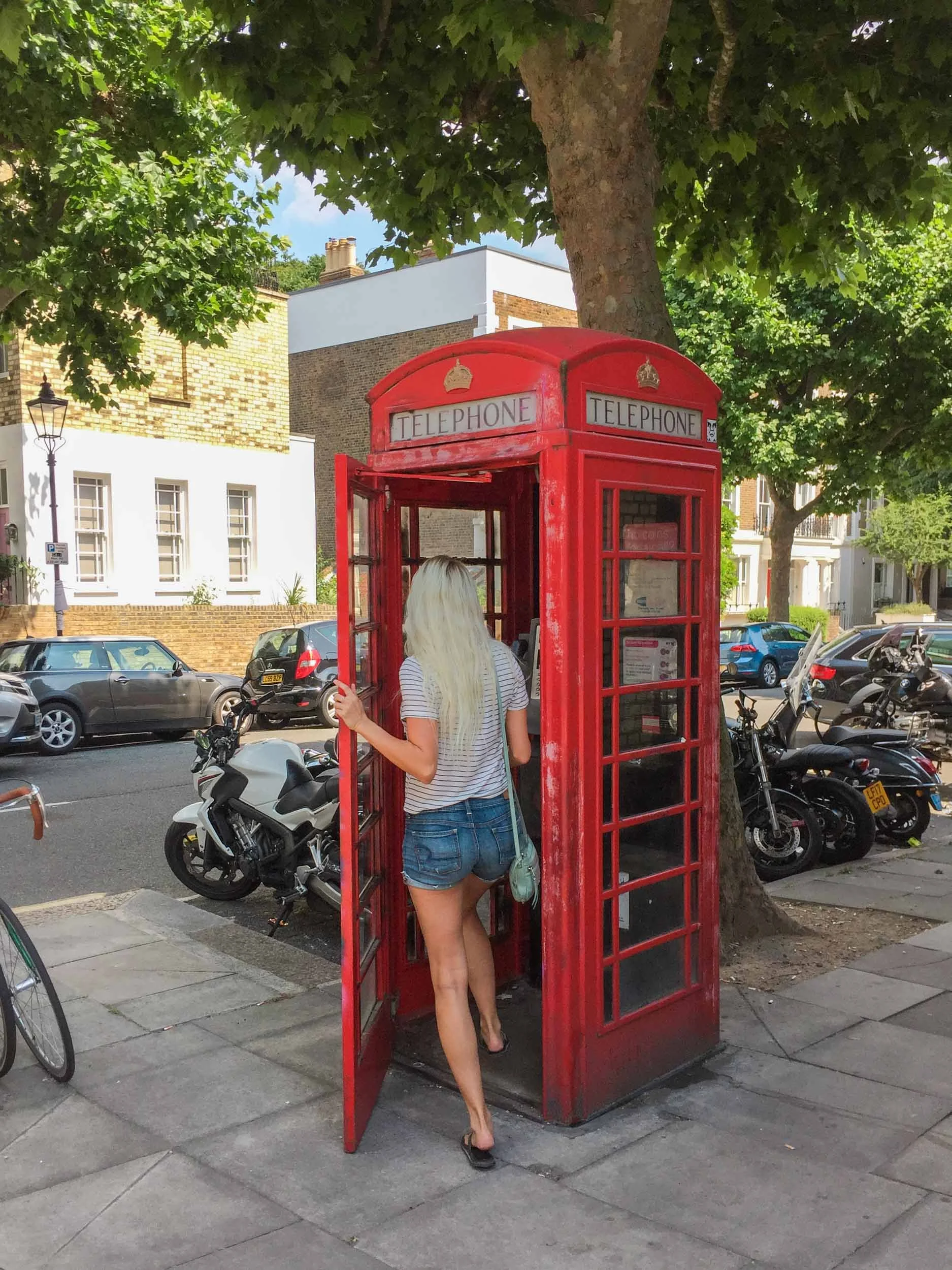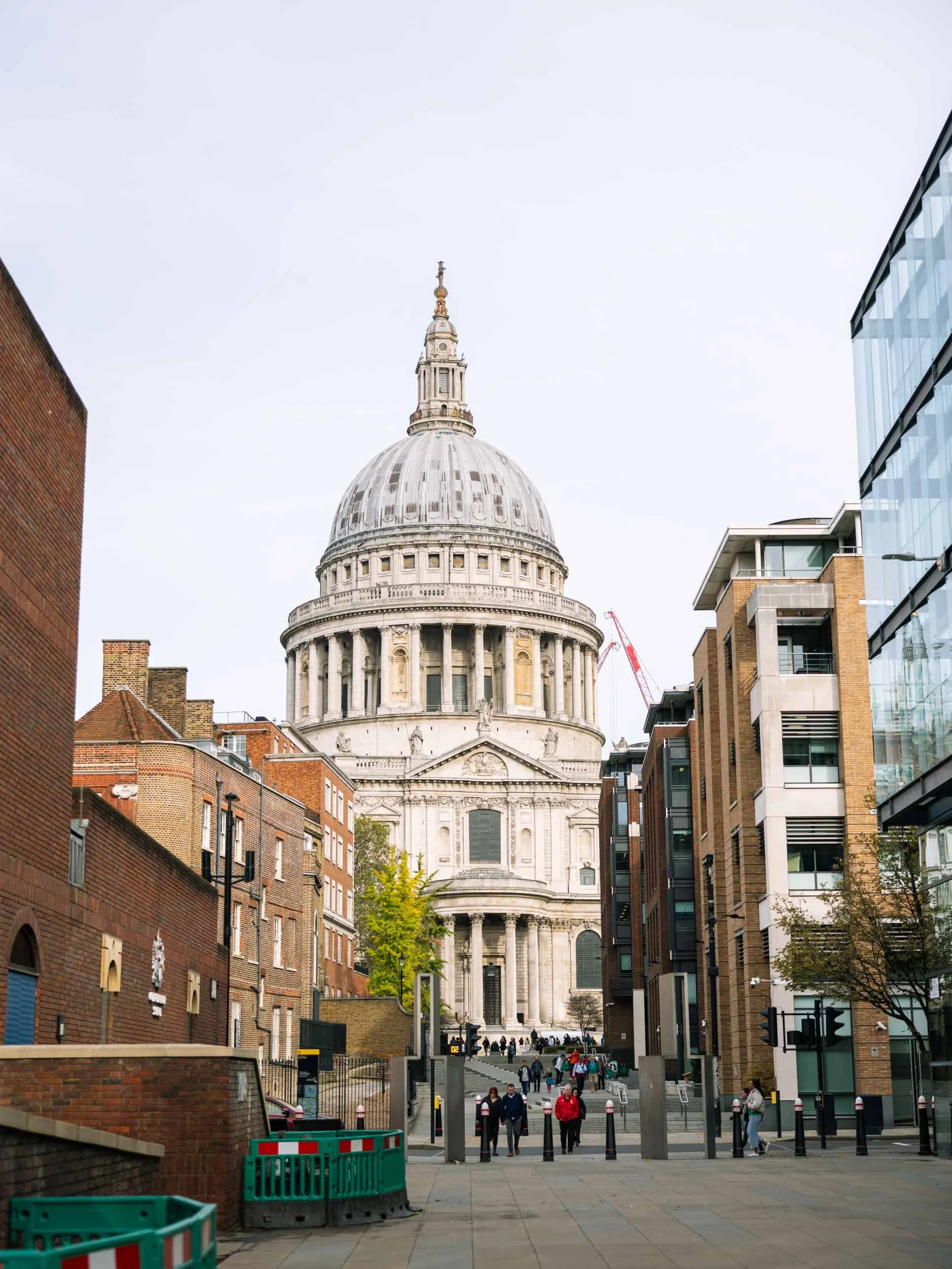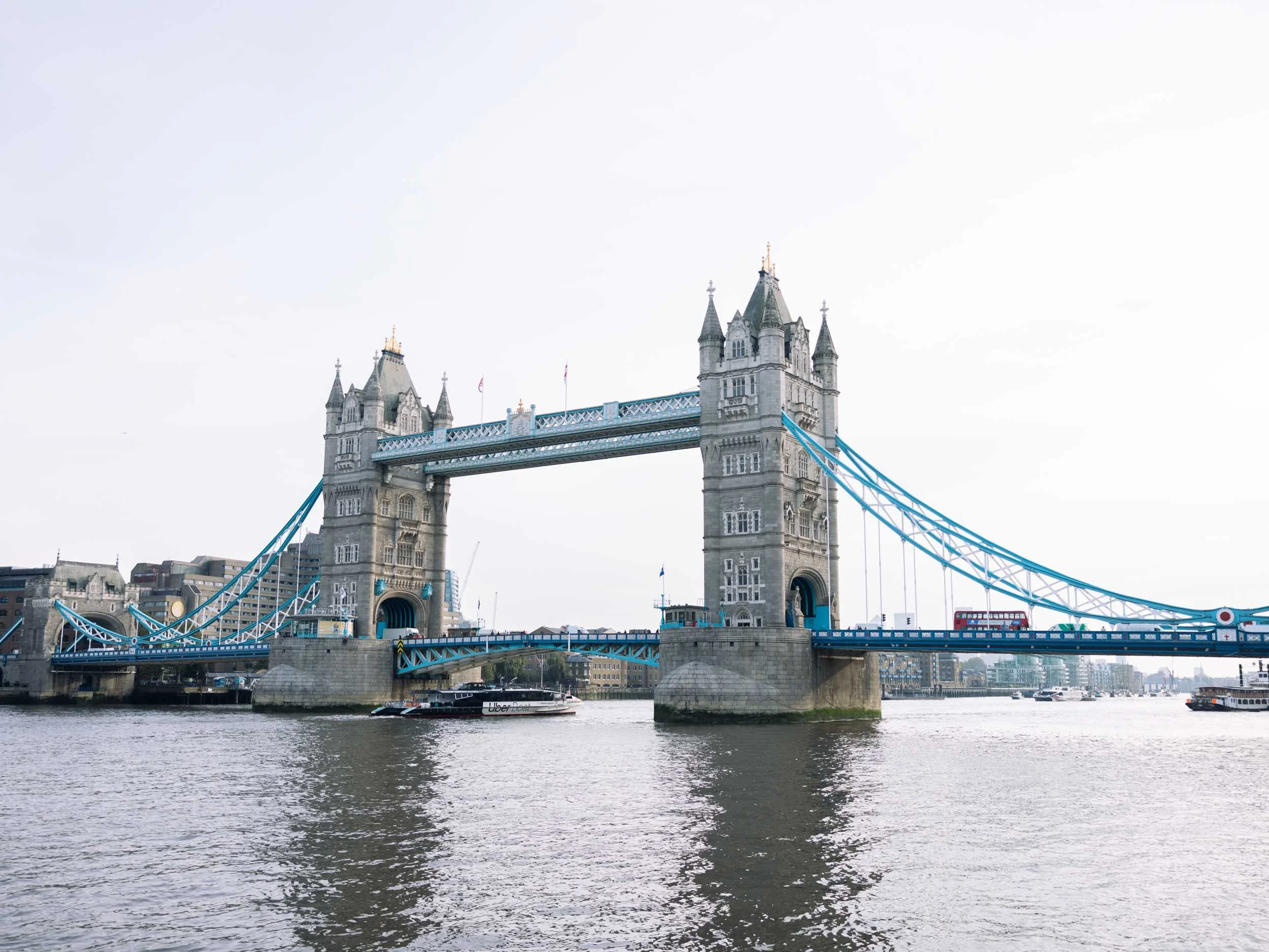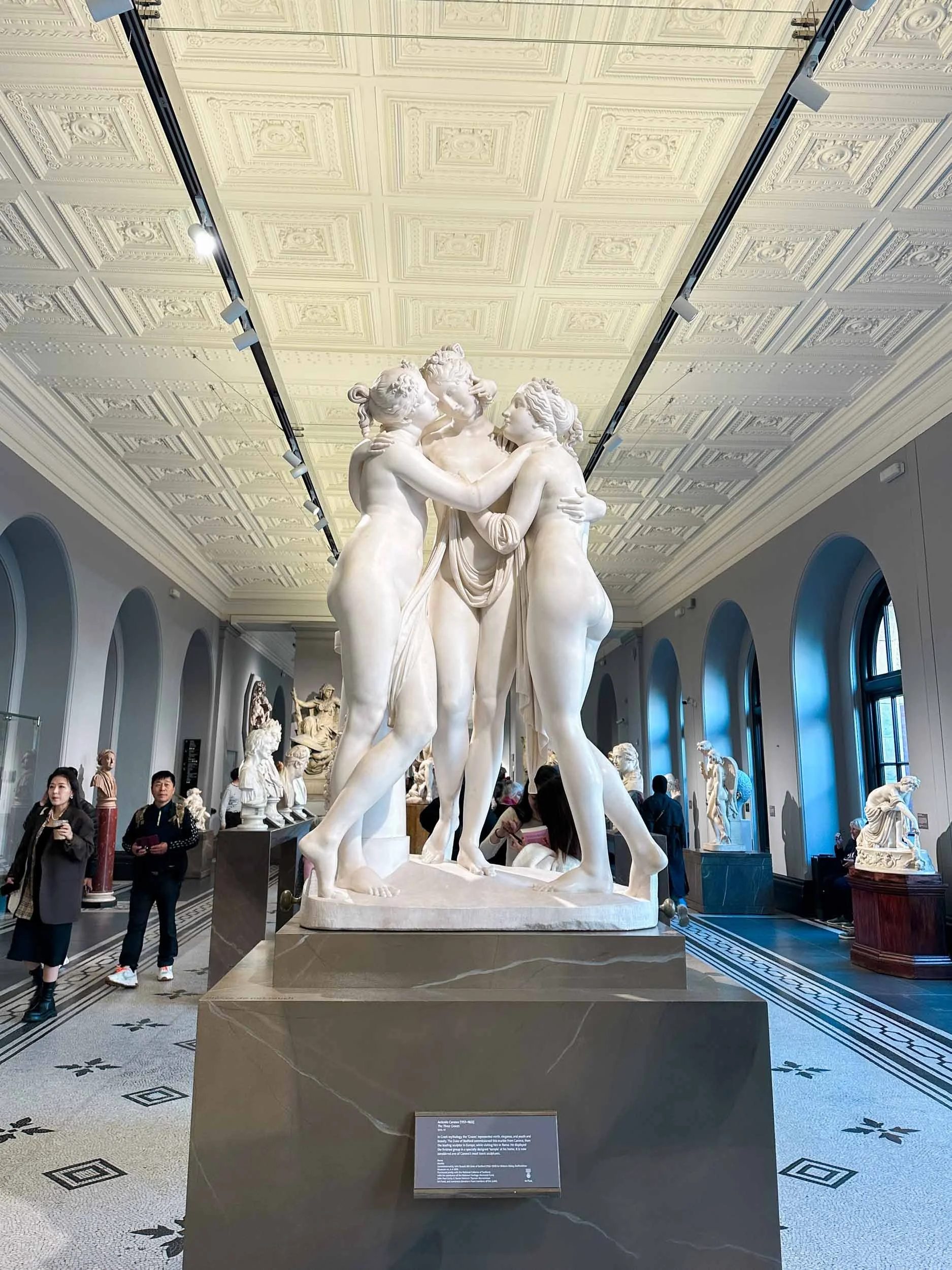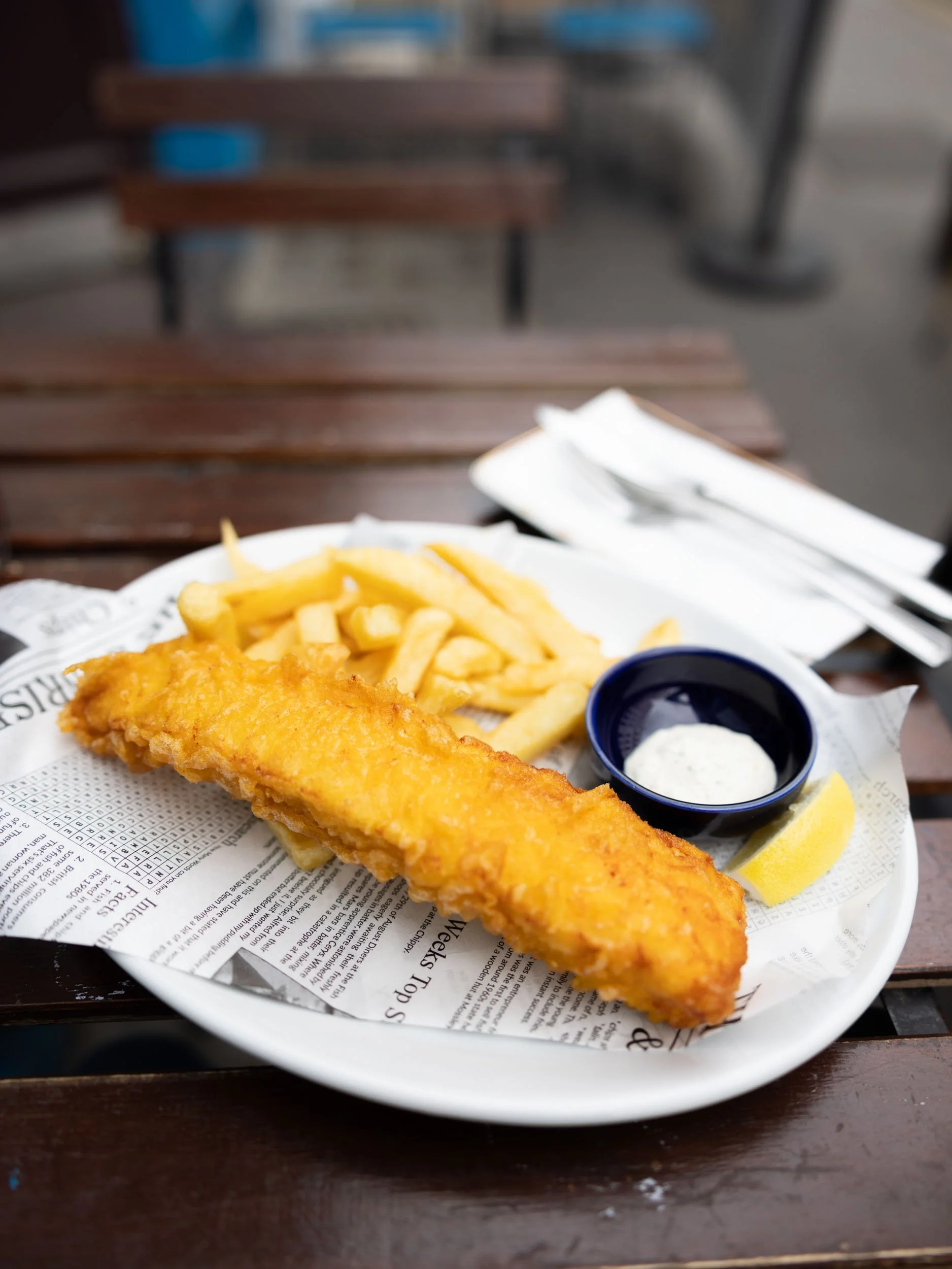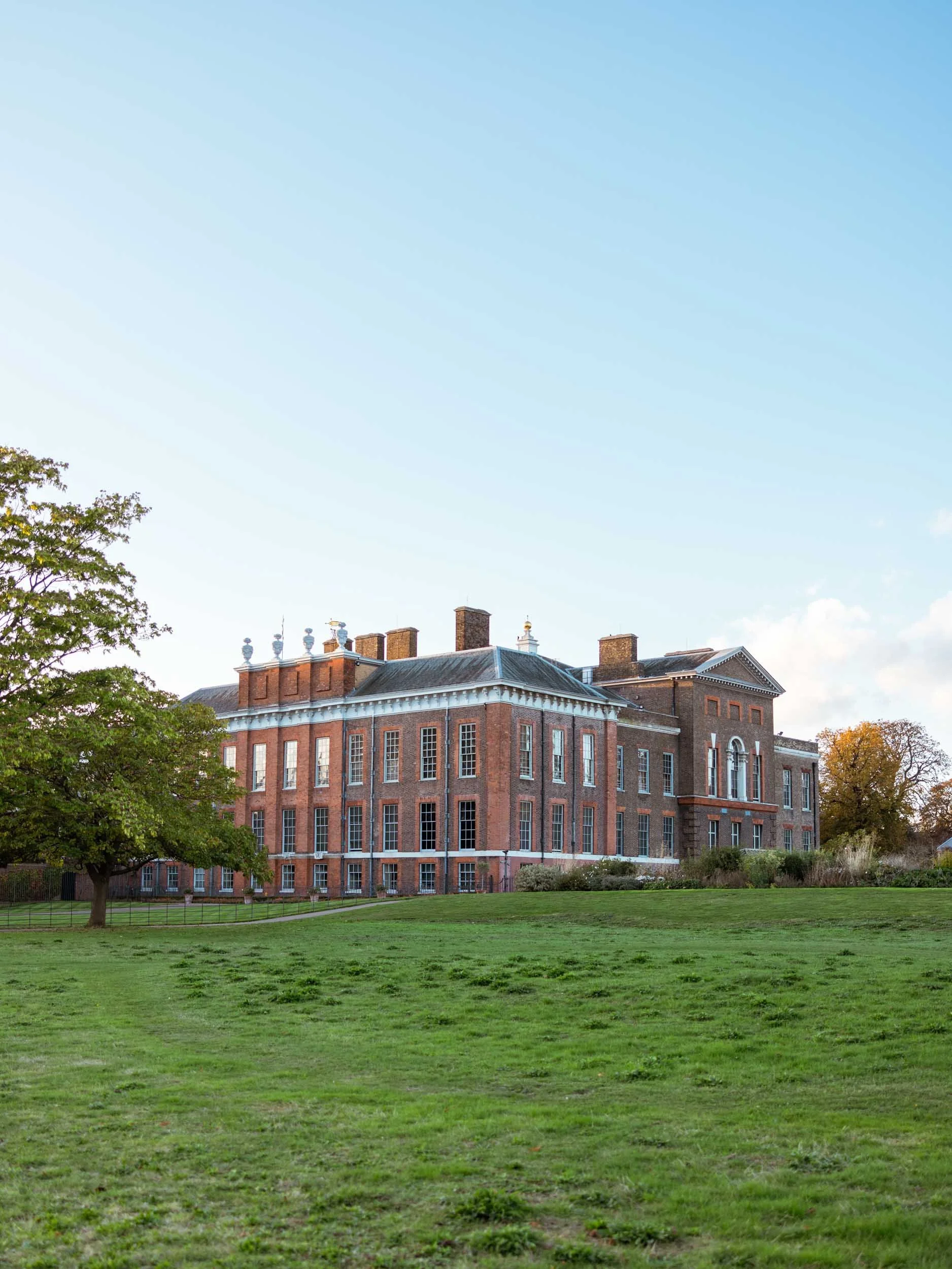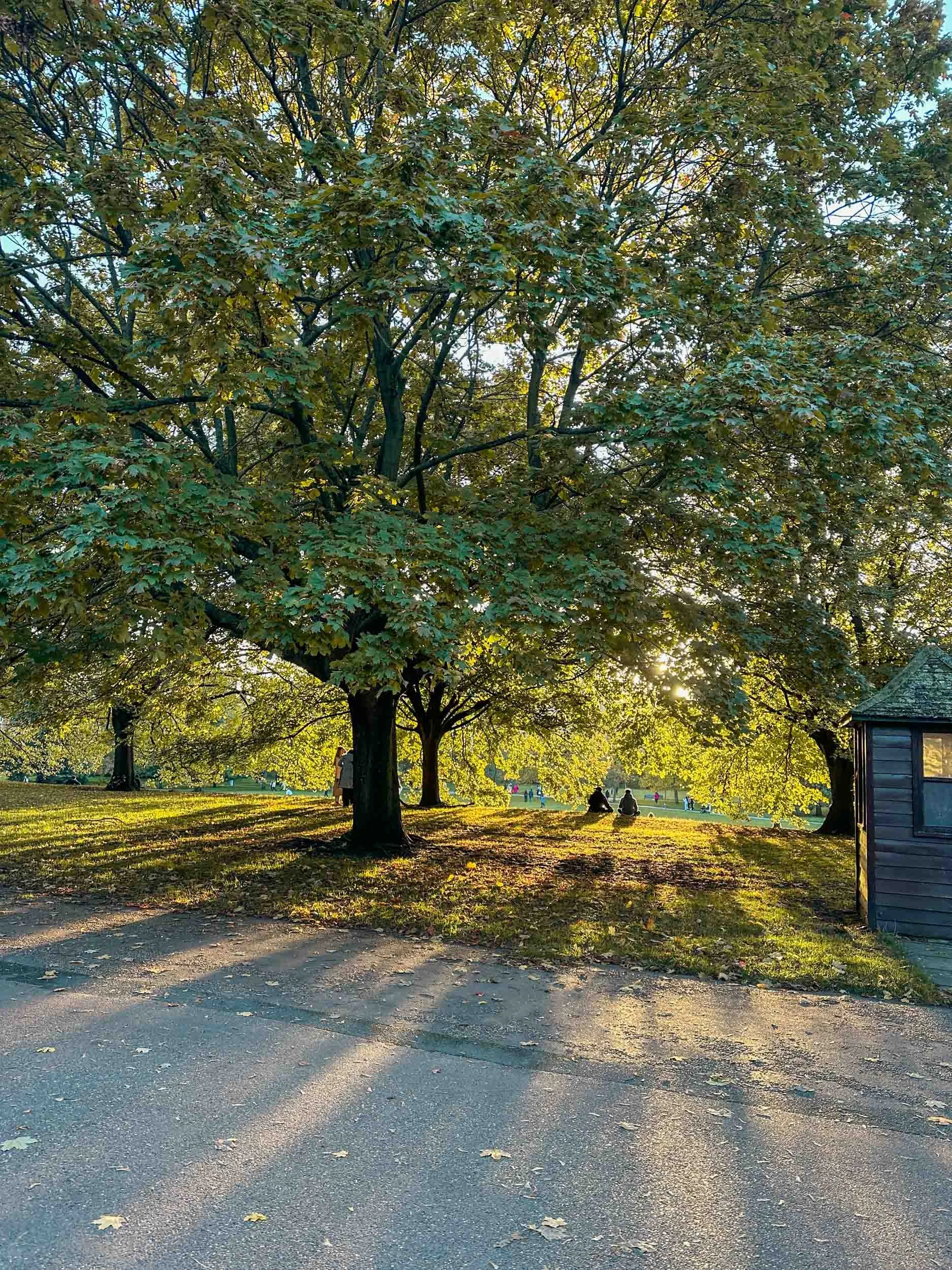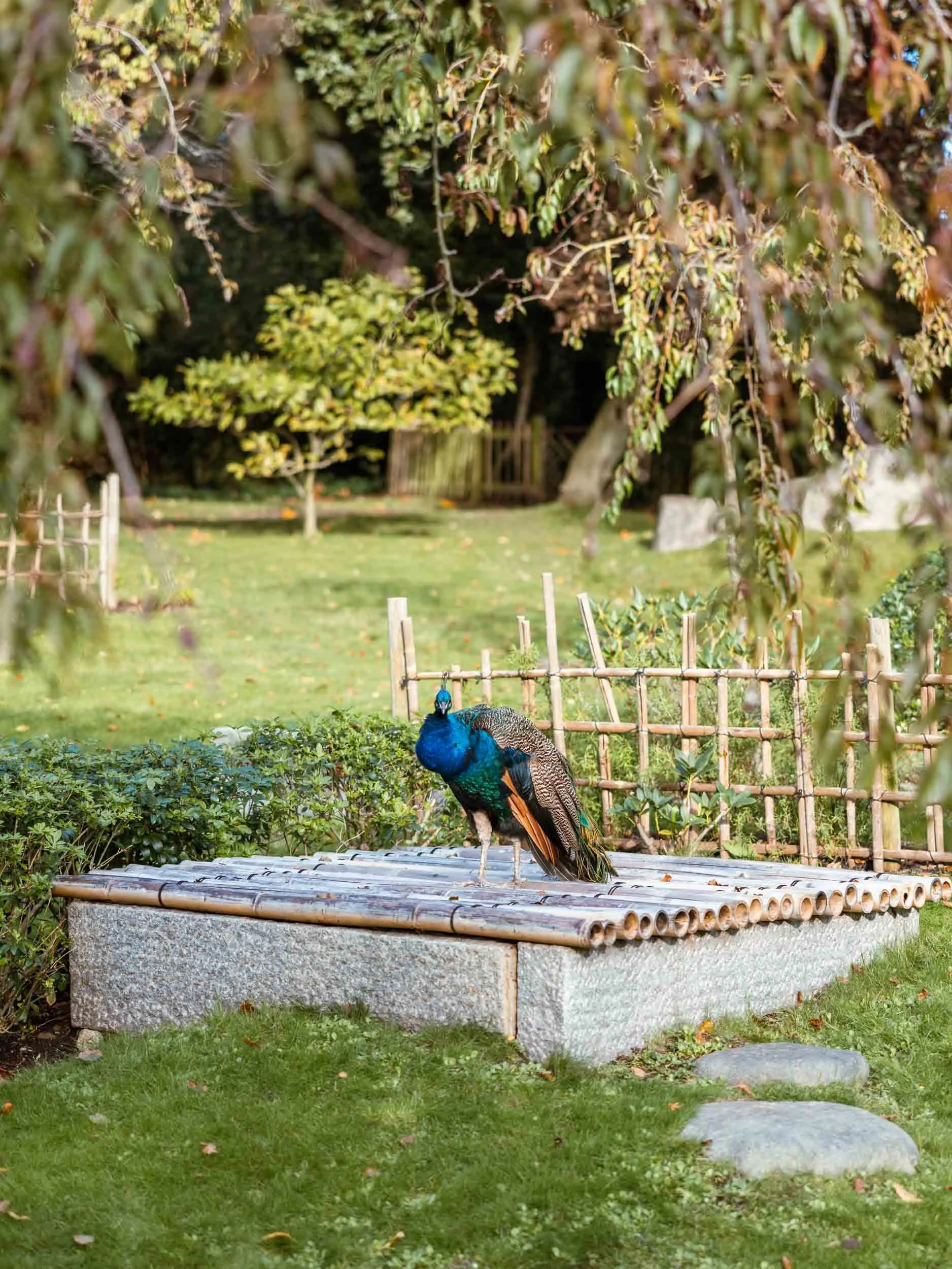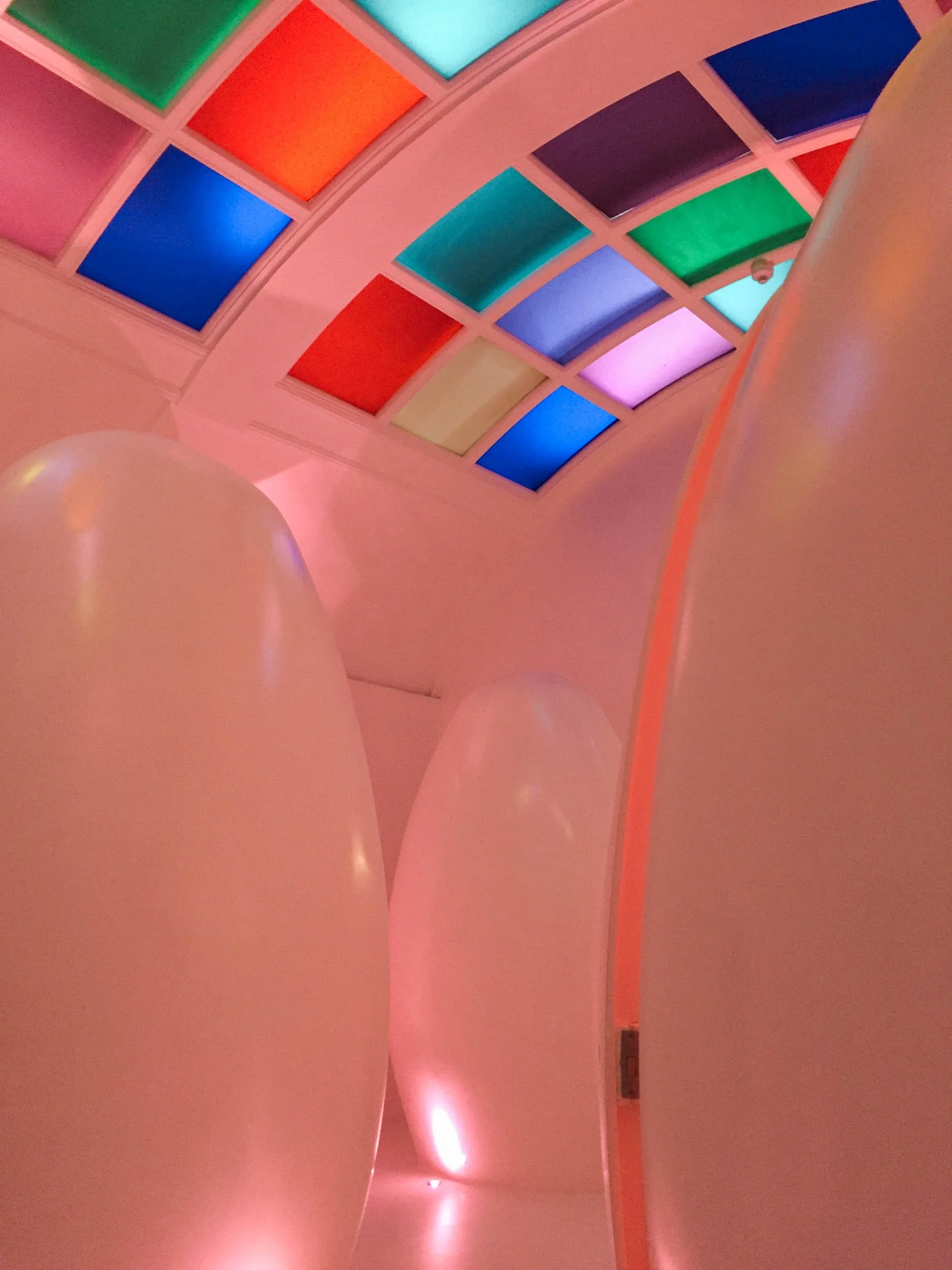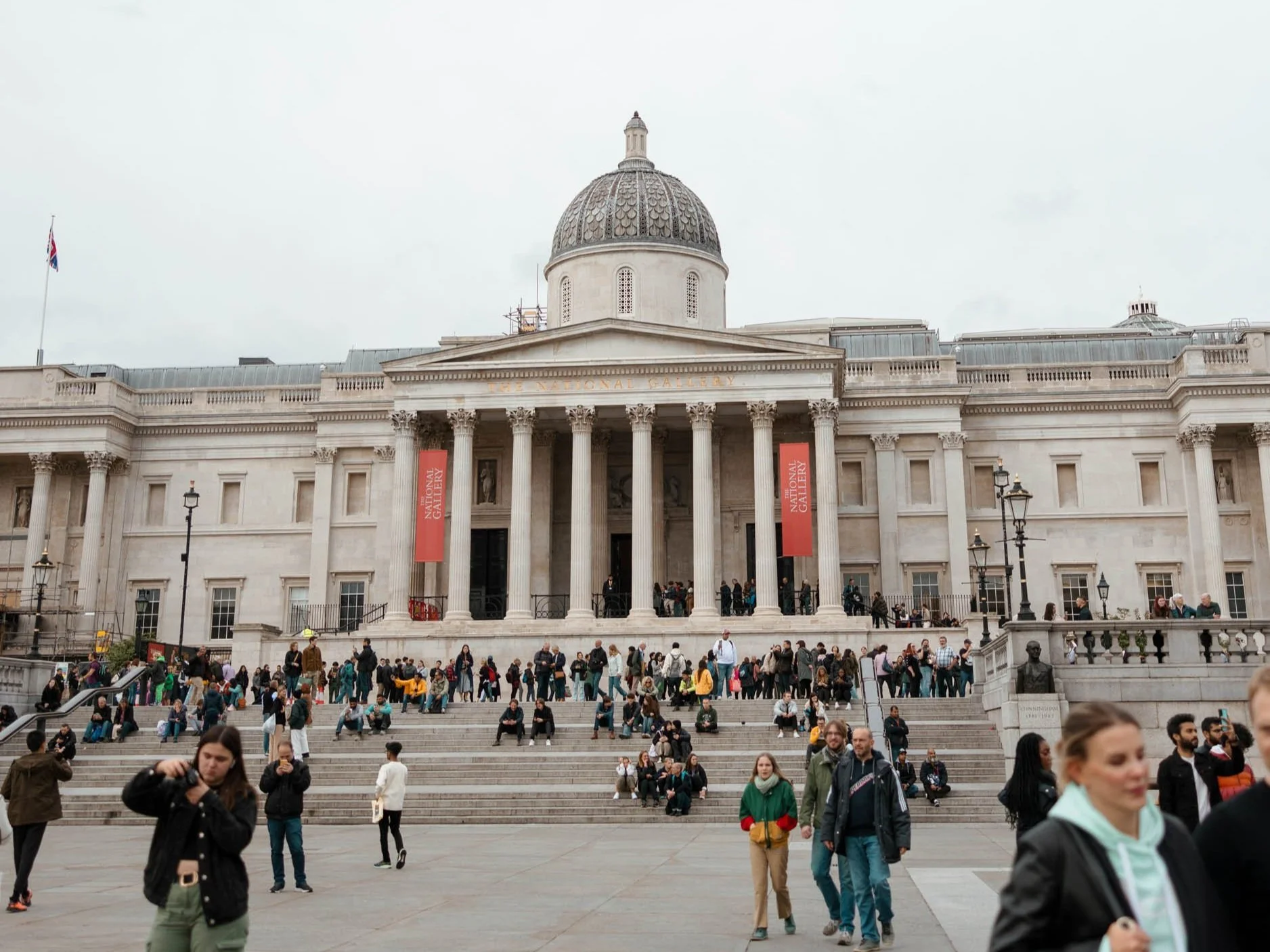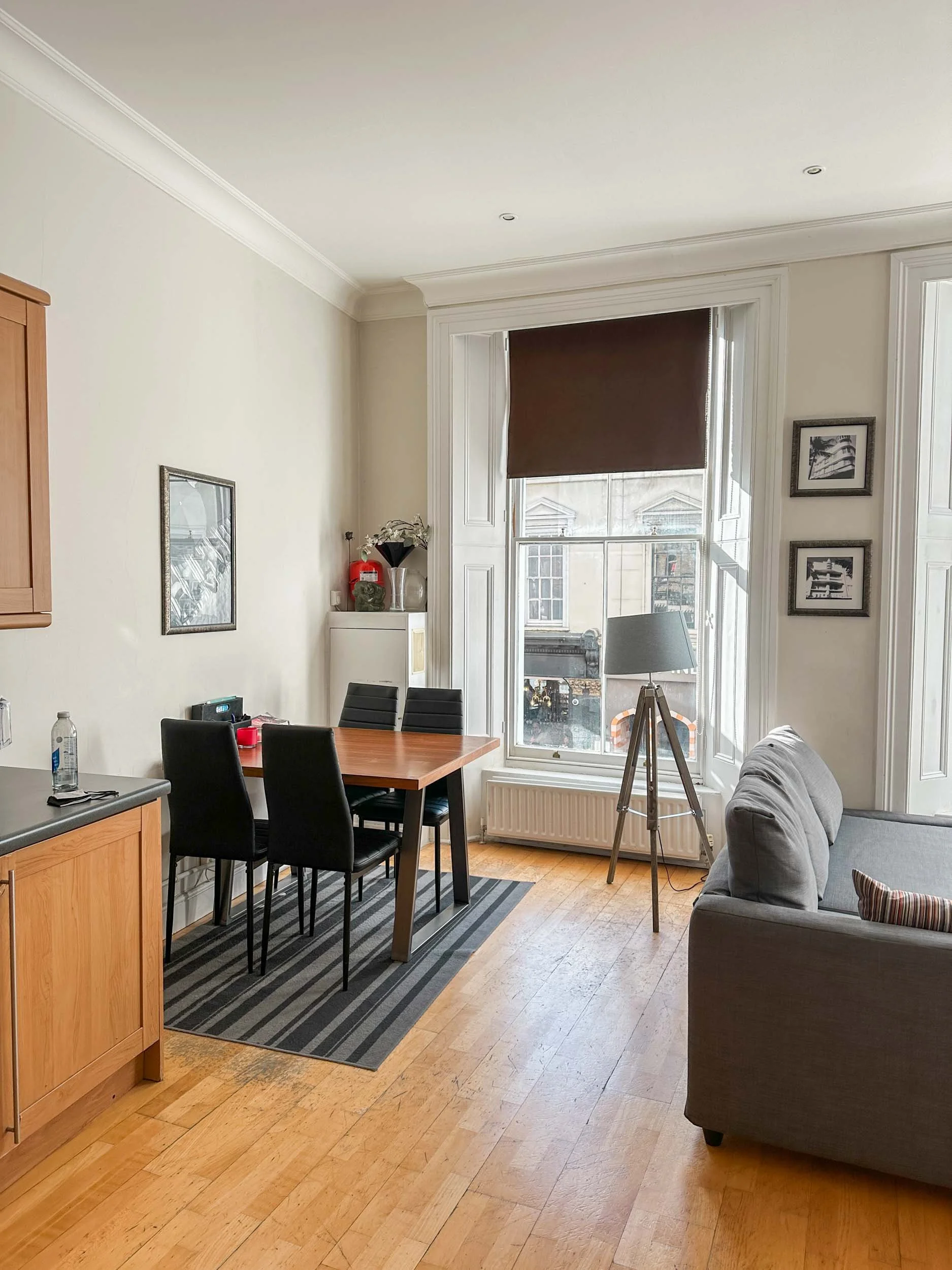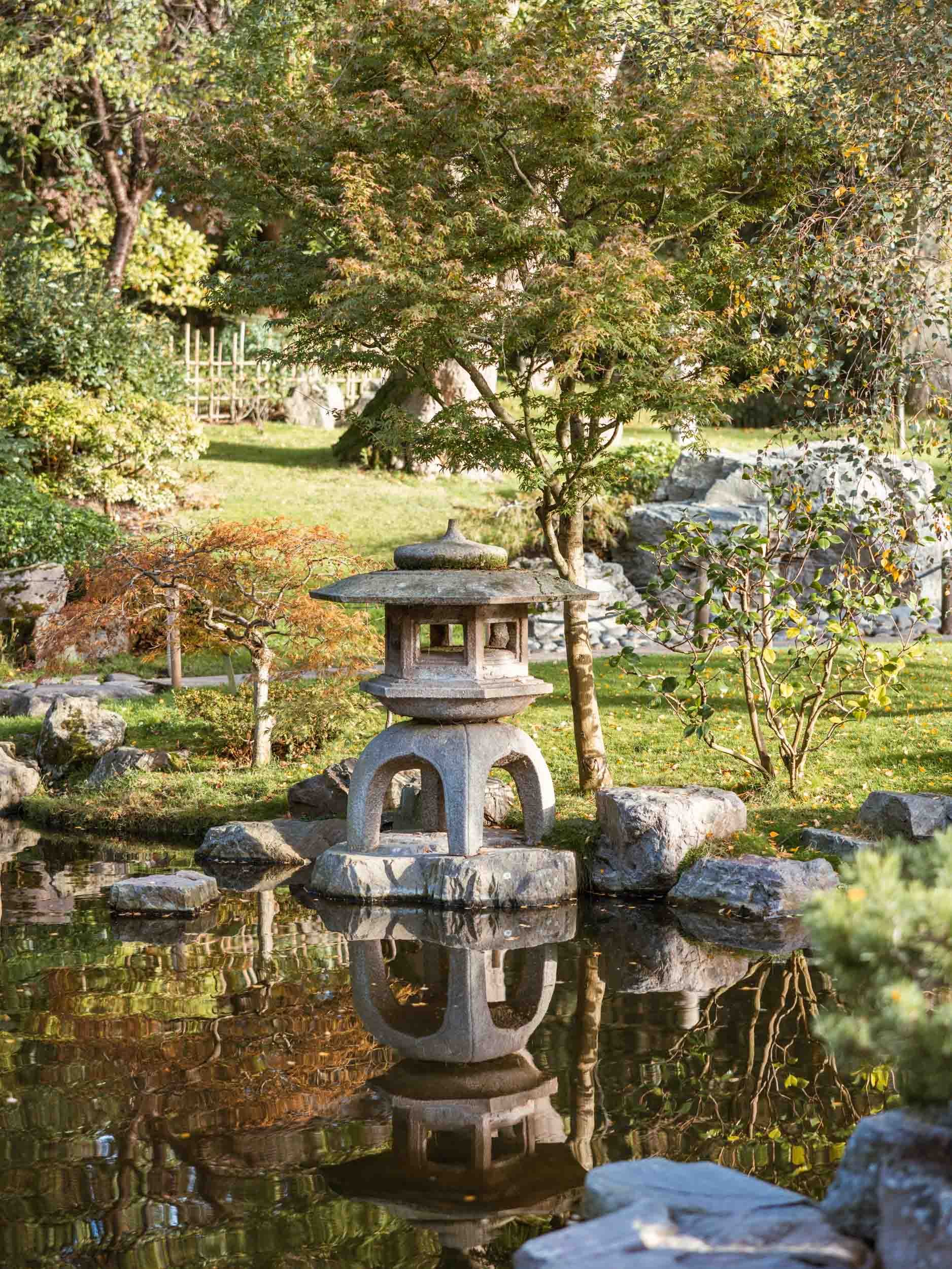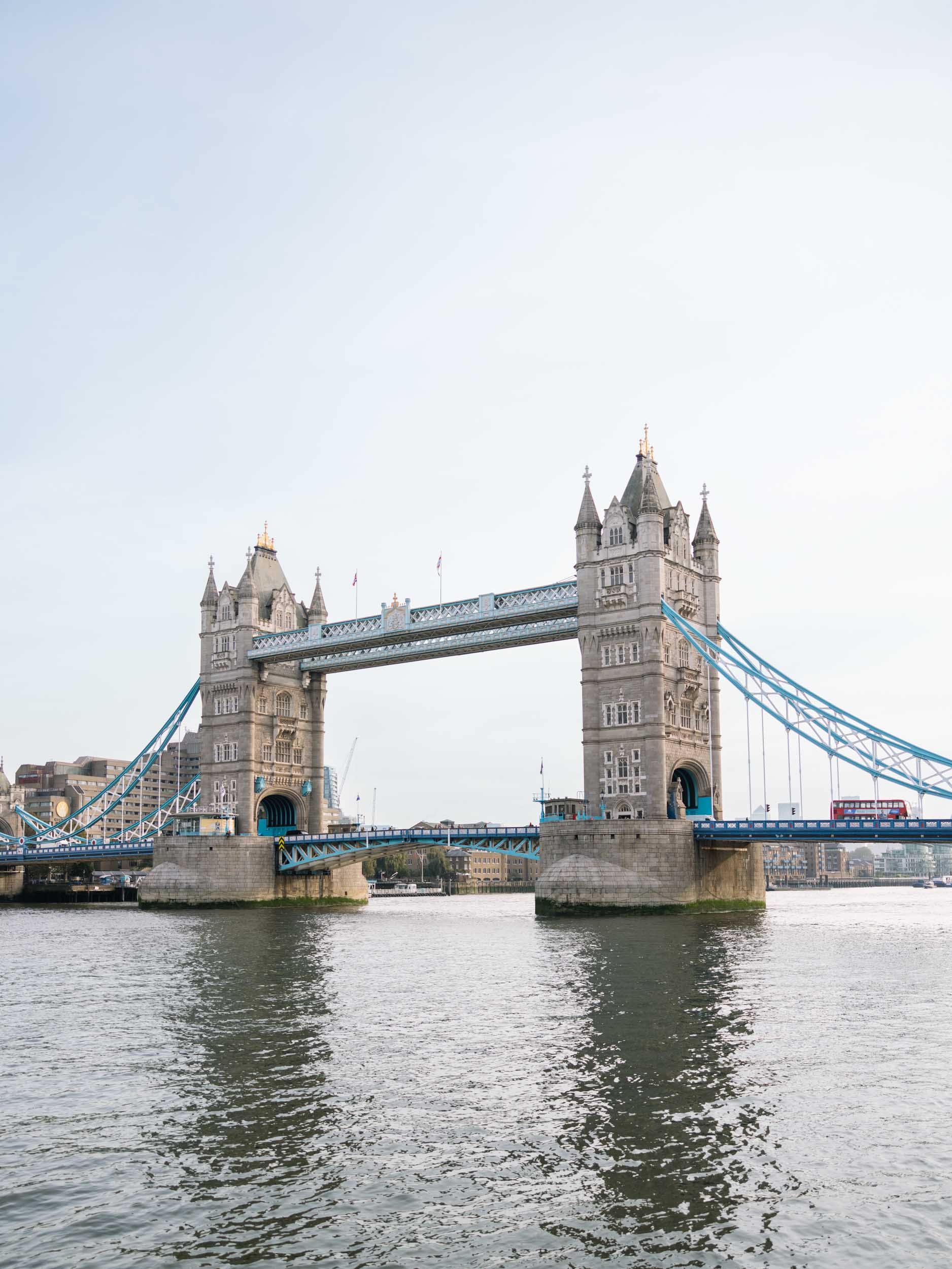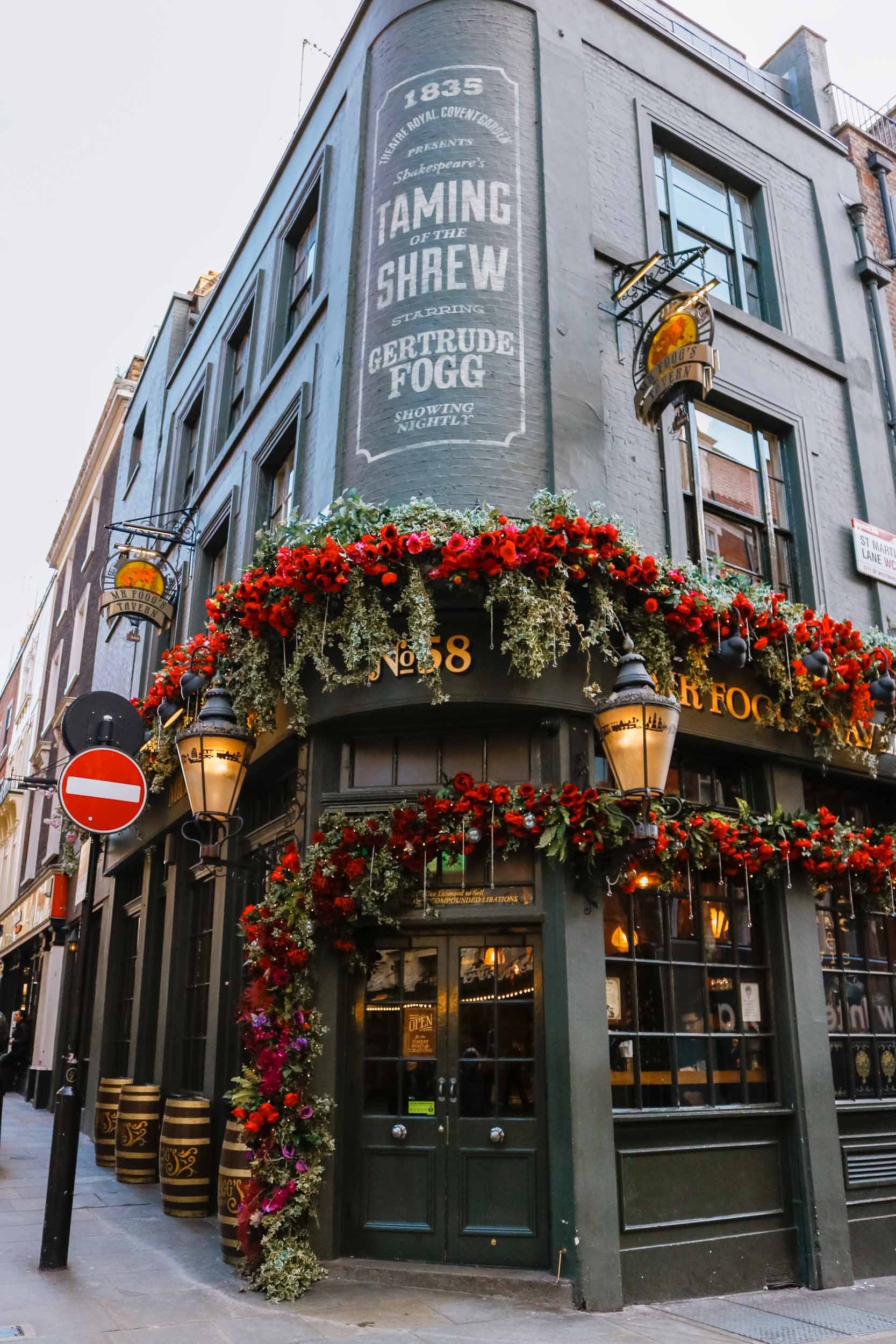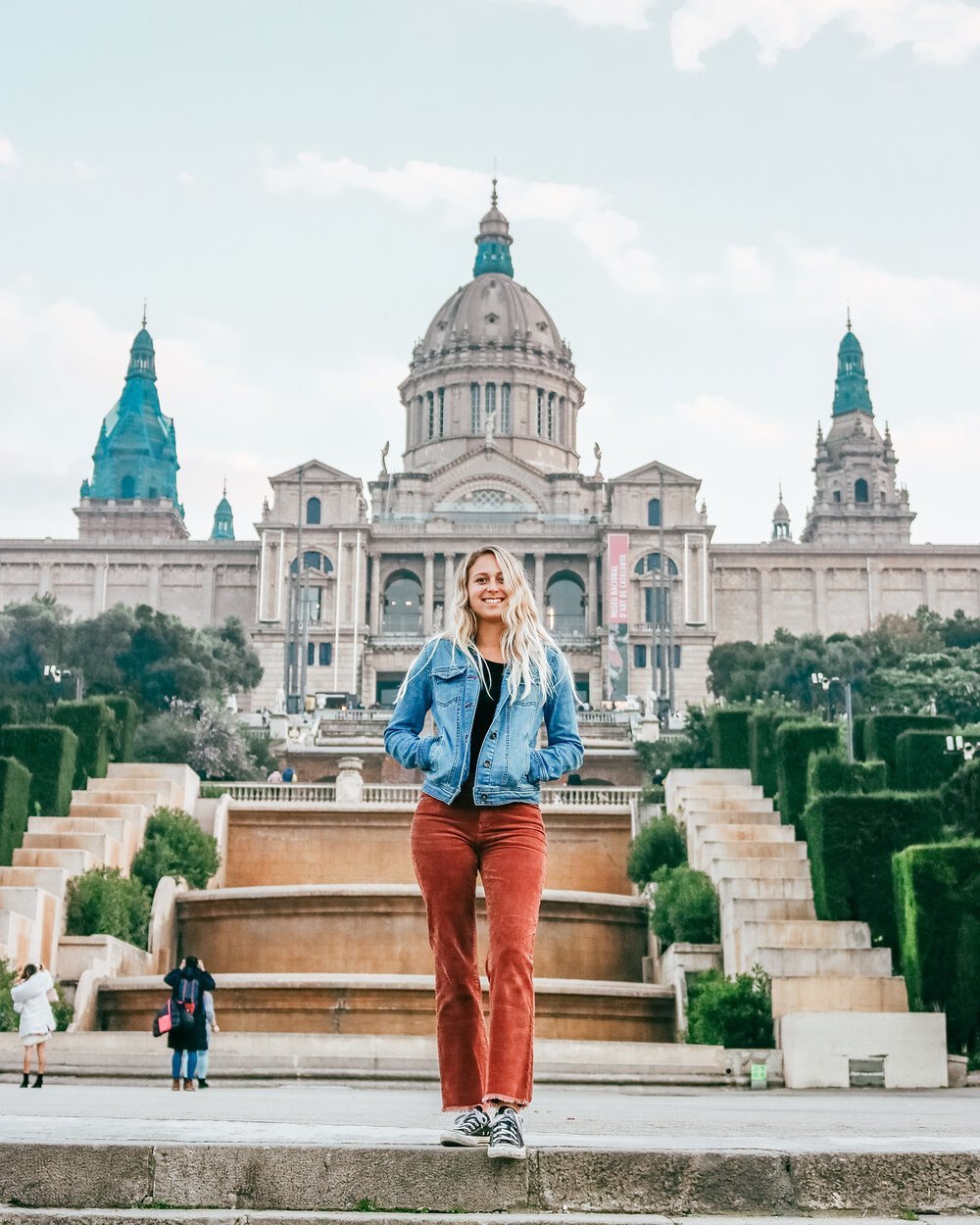London Travel Guide for First-Time Visitors
Published May 2019 | Updated January 2025
Visiting London for the first time? This London travel guide has everything you need to know before your first trip to this lovely city.
Planning a trip to a big city for the first time can be overwhelming. You have to figure out public transportation, pick accommodations in a good area, and determine what to do there.
This guide covers it all, including all the information you need to know before you go, plus my recommendations for things to do, places to eat, and where to stay in London.
This post contains affiliate links that earn me a commission. For more information, read my disclaimer.
London is in southeastern England, with the River Thames (pronounced Temz) running through it horizontally. It’s globally known for being the home of the British Royal Family, who live in the various Royal Residences throughout the city.
It’s easy to romanticize places we’ve only seen or heard about in books, TV, and movies, but London truly is a place you will want to keep going back to.
If it weren’t for the cold and rainy weather part of the year, I could see myself renting a cute flat and living there!
I would buy flowers at the market on the weekends, stroll through the many parks, pop into the free art museums during lunch, and grab some fish and chips at a local pub after work.
I’ve always found the people in London to be polite and friendly, and there’s just something about that British charm. Possibly the accent? Definitely the accent.
Whether this is your first time in London, or maybe it’s been a while since your last visit, this London travel guide will help you prepare for your trip and navigate the city throughout your stay!
Tips for Visiting London
Don’t Overload Your Days
London has fun activities, incredible museums, and iconic sights. It’s understandable if you want to pack your days full to see EVERYTHING on your first trip to London!
You can pack your days full (I do for every trip!), but leave some time between each itinerary item in case you want to spend more time on an activity than you originally planned.
It’s even nice to leave a large gap or two each day so you can have space to be spontaneous or give yourself time to head back to your accommodation for a nap or some rest.
With so much to do and see in London, trying to see it all on your first trip may be overwhelming. Try making a list of your must-see things in London and assume you can only see 2-3 each day.
You will likely have time for more activities/sights per day, but adding just 2-3 per day to your itinerary will ensure you get to do your top priorities. You can make a list of secondary activities/sights to pick from each day once you see/do your top priorities!
Have an Itinerary With Backup Options
Sometimes an activity just doesn’t work out. In those instances, have a backup plan you can quickly pivot towards to avoid losing time.
For example, when I arrived at the Natural History Museum and saw the wait time to get inside was over two hours, I quickly pivoted to a backup activity: getting a chai latte and croissant to enjoy before heading to my next itinerary item.
Tip: You can book your FREE tickets online one day in advance and skip the line at the Natural History Museum!
If you already created a list of your secondary activities/sights (as mentioned above), then you should have a nice list to pull from in case one of your primary, must-do activities doesn’t work out.
Take Advantage of Free Activities
Big cities can be expensive, but London has tons of free activities that will fill your days without spending any money!
Between the free museums, lovely parks, and other fun attractions, you can save your budget for accommodations and meals while enjoying all your activities for free.
Download Offline Maps
Despite having an international phone plan, my service is unreliable and doesn’t work well abroad. You can get a physical sim card in London to ensure you have service during your trip, or even buy an electronic sim card (e-sim)!
Even if you get a sim card, download the map of London offline in the Google Maps app so you can access it when you don’t have service. I do this for all of my trips! It’s helpful to have the ability to navigate when you don’t have access to cell service or wifi.
Protect Against Pickpocketing
All big cities have some petty crime, London included. When traveling, basic safety precautions are important for life safety and protection against theft.
My favorite anti-theft accessory is an anti-theft backpack. I wear this while exploring without worrying about someone accessing my backpack since the zipper is against my back.
When I’m on public transportation, I take my backpack off and put it in my lap with the zipper facing my body. Don’t put your backpack/purse on the floor or seat next to you, as it can be pickpocketed in these locations.
Helpful tip: Keep your phone close to you and stay alert. Thieves may try and grab your phone out of your hands and run/bike away if you aren’t paying attention.
This can happen on public transportation, on the street, or anywhere else you may have your phone out around crowds.
Make Reservations For Activities & Restaurants
If you want to visit a popular restaurant or take tours, make reservations and book tickets online to ensure your spot. Some activities, like the London Eye, even give you fast-tracked admission if you buy tickets online in advance!
Important Things to Know
If you are visiting London for the first time, there are many things that you may not know about it. That’s okay and expected — you can’t know what you don’t know!
Watching British shows will give you a peek into British culture, but there are some things you just need to visit the UK to learn more about. This list gives the basics to help make your trip go more smoothly.
Language
English is the official language in England — no surprise there! They speak British English, which does have a few different words than American English.
Some notable British words/slang that are useful to know:
Fag = cigarette
Chips = fries
Flat = apartment
Bloke = dude/man
Loo = toilet
Quid (slang for pounds) = bucks (slang for dollars)
Dodgy = sketchy
Pissed = drunk
There is much more British slang, which may sound funny to someone visiting London for the first time. The above are the slang words you will likely hear most commonly!.
Currency
All of the United Kingdom uses the British Pound (£), also known as the pound sterling, but usually just referred to as the “pound.” It is not the same as the European currency, which is the Euro (€).
Outlets/Plugs
They use Type G plugs in London. This is also called the “Commonwealth Plug” because it’s used in all Commonwealth areas, including Malta!
The universal adapter I use works great with Type G plugs.
Cash vs. Card
I have never needed to use cash in London, as it is a very card-friendly city. Every place I’ve been has taken contactless payments, meaning all I needed to do was tap my contactless-enabled credit card or phone to pay for meals, transportation, or activities.
It’s always useful to carry a small amount of cash and/or coins with you in case you need it, but I wouldn’t take out or exchange a large amount for a trip to London.
Tipping Culture
Restaurants: Tip 10-15% if the gratuity was not already added to the bill. Look for a service charge or gratuities on the bill to see if the tip was already charged before you add a tip! If there was a tip added to the bill, you do not need to tip on top of it.
Bars/pubs: No tip needed. If you get change back, you can leave some of it as a tip if you choose to, but it is not expected.
Other places you may want to tip:
10-15% for minicabs or black cabs
Hotel staff (concierge and door staff if you want to, and any amount for cleaning staff and porters)
Roads/Crosswalks
Look right when crossing the street! They drive on the left side of the road in the UK, including London. If you’re coming from a country where they drive on the right side and this is your first time in London, it may be a bit of an adjustment when you first get there.
When catching buses, ensure you’re on the correct side of the street to get on a bus in the direction you need to go. It will be the opposite compared to right-side driving countries!
London locals often cross the street before the crosswalk gives you the “walk” signal. As a visitor, I recommend waiting for the signal to avoid any potential collisions with cars, bikes, etc. It’s just safer and will save you some embarrassment. I’ve seen a few near-misses on every trip to London!
Top Things To Do in London
I’ll say it again, because it’s so true, but there is SO much to do in London! I’ve spent weeks in London across all my trips and still have yet to do it all.
My list of things to do in London also continues to grow as I learn about more activities or sights I haven’t done or seen yet.
If this is your first time in London, pick your top things to do and do those first! If you have time after crossing off your top priorities, you can do more things on your list.
Visit the Museums
One of my favorite things about London is the museums! Not only are they full of impressive artwork and artifacts, the majority of them are completely FREE.
There is no shortage of free things to do in London, but I would recommend starting with the museums — they’re some of the best I’ve ever been to!
My top London museum recommendations:
The National Gallery
Nearby tube stops:
Charing Cross (Bakerloo and Northern Lines)
Leicester Square (Northern and Piccadilly Lines)
Victoria and Albert Museum
Nearby tube stop: South Kensington (Circle, District, and Piccadilly Lines)
The British Museum
Nearby tube stops:
Russell Square (Piccadilly Line)
Tottenham Court Road (Central and Northern Lines)
Tate Britain
Nearby tube stop: Pimlico (Victoria Lines)
Natural History Museum
Nearby tube stop: South Kensington (Circle, District, and Piccadilly Lines)
Take a photo with Big Ben
Big Ben is the nickname for the large, iconic clock in Elizabeth Tower in Westminster. Although the full tower is called The Elizabeth Tower, and Big Ben is just the clock inside of it, you’re not likely to hear it referred to as anything except Big Ben.
Big Ben is part of the Houses of Parliament and next to Westminster Abbey, Westminster Bridge, and the London Eye. With all these iconic landmarks, this area can get busy during peak tourist season and midday when most people are out and about.
The best photo spots to get a shot with Big Ben are on Westminster Bridge and the K2 Telephone Boxes across the street from Parliament Square Garden. There is sometimes a line for a photo at the telephone box since it’s a well-known Instagram spot!
Nearby tube stops: Westminster (Circle, District, and Jubilee Lines)
Visit Buckingham Palace
Buckingham Palace is the home of the royal family. It’s a grand palace with stoic guards who attract large crowds when they end their shifts, known as Changing of the Guards. It is one of the most popular tourist attractions in London!
The Changing of the Guard is a ceremony/performance that happens daily between April and July. If you’re visiting outside of the season, the ceremony takes place every other day instead of daily.
Near Buckingham Palace, you can admire the Victoria Memorial and rose garden in front of the palace or walk through one of the neighboring parks.
Nearby tube stops:
Green Park (Jubilee, Piccadilly, and Victoria Lines)
Hyde Park Corner (Piccadilly)
Victoria (Circle, District, and Victoria Lines)
Eat Fish and Chips
One of the most well-known dishes in England is the classic fish and chips! London’s pub culture offers tons of options for places to get a fish and chips meal, washed down with a pint of beer.
Side note about British food: Before I visited London for the first time, I had only heard bad things about British food. While I am still not a fan of mushy peas, I think London has great food!
Most big cities have a great variety of restaurants, with food from all different cultures. One of the most popular restaurant chains in London is an Indian restaurant called Dishoom. It’s delicious!
Walk across Tower Bridge
Tower Bridge is arguably the most attractive bridge in London. It’s immediately recognizable and, because of its icon status, it is often confused for being the London Bridge.
The real London Bridge is not quite as visually impressive, but it is still worth a visit since it is the London Bridge, after all!
You can walk across Tower Bridge on the pedestrian walkways on either side for free — no entry ticket required. If you want to go up into the tower, you can buy tickets to explore it and take in the panoramic views.
Nearby tube stop:
Tower Hill (Circle and District Lines)
London Bridge (Jubilee and Northern Lines)
Stroll through Kensington Gardens
Kensington Gardens has a large grassy park area, a round pod, and Kensington Palace. There are multiple pathways shared by pedestrians and cyclists that are lovely to walk around in the afternoon — it’s especially beautiful at golden hour.
On the south side of the gardens, you can enter via Broad Walk and grab a coffee, tea, or bite to eat at COLICCI Cafe! Their chai latte was great and the perfect thing to sip on as I walked around the gardens.
Broad Walk is one of the widest, pedestrian/bike-only pathways in Kensington Gardens and the one I chose to walk down! It takes you right past Kensington Palace and the Round Pond, which is full of geese and swans enjoying a swim.
Nearby tube stops:
Queensway (Central Lines)
Bayswater (Circle and District Lines)
Notting Hill Gate (Central, Circle, and District Lines)
Find Peacocks in Kyoto Garden
Tucked into Holland Park is a Japanese Tea Garden called Kyoto Garden. It’s a small, lush garden with a waterfall that delicately flows into the large pond.
You may spot some squirrels darting around the park, birds perching near the water, or even peacocks walking around the garden!
Recommended post: Kyoto Garden in Holland Park: A Japanese Garden in London
Nearby tube stops: Holland Park (Central Line)
Catch a Train at Platform 9 ¾
King’s Cross station is where you will find a trolley stacked with luggage and an owl cage halfway through the wall, Harry Potter-style. It’s a tourist trap—though still worth visiting—and the line to take a photo (which costs money) can sometimes be over an hour long.
I snapped this photo from the outside of the ropes right after one person left and before the next person walked up to get their photo!
Best Restaurants in London
Dishoom
The best Indian food I have ever had was at Dishoom. There are multiple locations throughout London, meaning you likely won’t need to travel far to reach one. Some notable locations you will likely be near during your trip are Kensington, Covent Garden, and Soho.
I have even waited in a long line to get Dishoom in Covent Garden. It’s a popular restaurant! They also do takeaway and delivery (via Deliveroo) if you aren’t up for a sit-down meal.
Draughts
Go to Draughts for drinks, dinner, and games! They have two locations: one in Waterloo and one in Hackney. We went to the one in Hackney. Reserve a table ahead of time and make sure you tell them you want to play games.
They have shelves stacked with board games that you can play while you wait for your food and for hours after you finish eating.
It's a fun, unique dinner place and they even have tasty vegan and vegetarian options!
sketch
The coolest loo in London can be found at sketch (intentionally all lowercase), a five-room experience serving tea, breakfast, brunch, lunch, dinner, and cocktails. Reservations are required and should be made well in advance (1-3 months)!
We had some delicious, fancy drinks in the Glade, a forest-themed room serving breakfast, brunch, and cocktails.
There are five different rooms at sketch, all with their own unique themes:
The Parlour: A tea room in the day and a bar with live music at night.
The Lecture Room & Library: Upstairs restaurant with THREE Michelin stars, open for lunch and dinner.
The Glade: Forest-themed room serving breakfast and lunch during the day and cocktails at night.
The Gallery: An art gallery and “gastro-brasserie” serving afternoon tea and dinner amongst the art.
The East Bar and Pods: Evening cocktail bar with alien egg-like pods, which are individual toilets (aka loos)!
It’s one of the most unique places you can visit in London, with so much creativity all in one place. Even their website is one of the coolest I have ever seen!
Their dress code is “Art Smart,” meaning you should wear an outfit you would wear to an art gallery. Dress cute, creatively, and with character, and you’ll fit right in.
Emilia’s Pasta
Emilia’s Pasta is at St. Katharine’s Docks, right on the water next to Tower Bridge.
It is a tiny, intimate restaurant with authentic, rich Italian dishes and mouth-watering pasta. Make sure to make a reservation here because it can fill up quickly.
St. Katharine Docks Cafe
Just a few doors down from Emilia’s Pasta is another trendy spot that’s great for brunch: St. Katharine Docks Cafe.
The interior is well decorated, the food is delicious (reminds me of my local Californian brunch spots), and it’s right on the water! The chai latte here is full of flavor, and they have non-dairy milk options, which is always a plus for me.
Barley Mow on Horseferry Rd.
After a trip to Tate Britain and Westminster Abbey, Barley Mow is a nice pub to stop for lunch away from the busy crowds.
I got vegan fish and chips, which are pieces of tofu wrapped in seaweed (for that fishy flavor) and then deep-fried like regular fish and chips! I was shocked by how good it was. They also have regular fish and chips, which I didn’t try, but reviewers love them.
The Salisbury Pub
The Salisbury Pub is a more touristy pub with tourist prices in Covent Garden. The crowd here is typically mostly tourists, but the food is great!
Despite catering more to tourists, this still has a very authentic London pub feel and has the food and beer to go with it. It’s a great stop for lunch after a day of shopping in Covent Garden.
Fish Plaice
After exploring the 2+ million artifacts at The British Museum, pop over to Fish Plaice for generous portions of fish and chips. They have a few different fish options to choose from, as well as their signature dish: Korean-style fried chicken (KSFC).
This restaurant is located on a cute street across from a large pub and within walking distance of The British Museum. You’ll spot it by the bright Mediterranean blue exterior!
Sushi Samba
London has some great sushi spots, and Sushi Samba is one of them. It’s an upscale restaurant with a strict dress code – we saw people turned away for wearing sports jerseys.
It is on the 38th and 39th floors of a tall building and has 360º panoramic views of the city. Book ahead of time because this is a popular place!
There are vegan and gluten-conscious menus, too! The sushi rolls are pretty standard sushi prices, but large dishes—and steaks especially (one is even £1,000!)—are a bit pricey. Reservations are required.
How To Get To London
Flights
You will most likely fly into London since the UK is an island! London has six major airports spread throughout the city: Heathrow Airport, Gatwick Airport, Luton Airport, Stansted Airport, London City Airport, and Southend Airport.
Heathrow and Gatwick are the two largest airports in London. I’ve flown in and out of both airports from California. I prefer Heathrow as it’s one of the closest international airports to the city center and flights are typically cheapest to Heathrow. Gatwick is more spread out than Heathrow, which can make it difficult to get from one gate to another.
London City Airport is the closest airport to the heart of London, but it is a small airport. It’s not possible to take a non-stop, long-haul flight to this airport, as the planes that arrive and depart from London City Airport are small. If you’re coming from Europe or elsewhere within the UK, then London City Airport may be a good option!
Trains
Some train routes run from the closest European countries to London and back!
Cities with trains to and from London:
Amsterdam
Rotterdam
Brussels
Antwerp
Paris
Lille
You can book your tickets through Eurostar and choose from Standard seats, Standard Premiere seats, or Business Premiere seats. Check prices between trains and flights to save money — flights may be cheaper and faster.
How To Get Around London
London has some of the best public transportation I’ve ever experienced. It’s a breeze to hop around the city without needing a car or ride share.
To find public transport routes, put your current location and destination into Google Maps and select the public transport icon. This will show you all the tube and bus routes, and their departure/arrival times.
In addition to public transportation, many people walk from place to place! It’s nice to walk around a lively city with other people doing the same thing. Even as a solo female traveler, I felt safe walking around London alone in all the areas I visited.
How to Pay for Public Transportation
There are a few different options to pay for trips on the tube, buses, and trains in London. The Transport For London website has a detailed breakdown of each option, but I’ve provided a shortened version below and added my own opinions/experiences.
Oyster Card
An Oyster Card is a blue plastic card, the same size as a credit card, that is used for paying to ride public transportation in London.
You can get one at any tube station — there are kiosks where you can select the type of Oyster card you want (Oyster Card or Visitor Oyster Card) and load it with your credit card or cash.
Only one Oyster Card can be used per person, so if you’re traveling with other people, they each need to get their own card.
You can use an Oyster Card for public transportation throughout London, including the tube and buses. It has a daily cap, which saves you money if you are taking the tube multiple times in a day (easily done when you’re exploring London!).
Visitor Oyster Card
There is a Visitor Oyster Card you can get, but it has fewer benefits than a regular one since you cannot load a travel pass onto it (great if you’re in London for 7 or more days!).
The main benefit to a Visitor Oyster Card is that you can have it shipped to your home before your trip, but getting a regular Oyster Card at the tube stations is very easy.
You cannot get a Visitor Oyster Card once you arrive in London — it can only be ordered and shipped to your home before your trip.
Contactless Payments
An Oyster Card is no longer required since the tube and buses in London now take contactless payments as of 2023 via your contactless credit card or digital wallet (Google Pay or Apple Pay).
Simply tap your contactless card or phone where you would tap an Oyster Card. They have the same benefits, including a daily cap on how much you are charged, as long as you use the same card throughout the entire day.
London Travelcard
Travelcards are prepaid cards you can purchase to get unlimited travel within specific zones in London. If you are planning to spend seven or more days in London, a 7-day Travelcard will save you money since it gives you seven days of travel for the price of five.
When you purchase an Oyster Card in London, you will have the option to purchase the 7-day Travelcard and load it onto your Oyster Card. Again, you cannot load a Travelcard onto a Visitor Oyster Card, only the regular Oyster Card you buy in London.
If you will be in London for six or fewer days, then skip the Travelcard and just get an Oyster Card or use a contactless payment. This will save you money on a trip shorter than seven days thanks to the daily cap!
London Underground (The Tube)
The London Underground, also known as “the Tube,” is the oldest subway in the world, founded in 1863. It’s the fastest and easiest way to get around London! I use it multiple times a day when I’m in London.
It has had many upgrades in the last century and a half, but many stations are not accessible for people who cannot walk up and down stairs. There are some accessible stations, which are noted with an International Symbol of Access (ISA)—an icon of a person in a wheelchair—on the Tube map.
Whenever you enter a tube station, you must tap your Oyster Card, contactless credit card, or digital wallet to get through the turnstiles. You will also need to tap on the way out as well, so have your card/phone ready as you leave the tube for the smoothest exit.
Each tube station has a map of the lines that run through that station and the stops they make. Before you get to a tube station, find the name of the stop/tube station nearest to your destination.
Buses in London
The buses in London are the classic red, double-decker ones you may have seen in photos or heard about. They’re another recognizable London icon that I didn’t even realize was a regular form of transportation in London until my first visit!
You can use your Oyster Card, contactless credit card, or digital wallet to ride the buses in London. All you have to do is tap to pay when you hop on the bus! The spot to tap is near the driver at the entrance — you can watch other people ahead of you if you are nervous about finding it.
If I have more than a 10-minute ride, I like to walk up the stairs to the second story for the best views and usually least-crowded seating. Be sure to head back downstairs before your stop so you have time to hop off the bus. Hold onto the railing well if you’re moving about the bus while it’s in motion!
Once the bus has departed from the stop right before yours, press the stop button (typically a square button on a vertical bar that says “STOP” on it) to let the driver know they need to stop at the next one.
Ride Share in London
Uber, Lyft, and Bolt all operate within London. With all these options, you can request a ride through their respective apps if you have cellular service or wifi.
If you’re coming from the U.S., Bolt may be new to you since it doesn’t operate in North America. I haven’t used Bolt in London yet, but we used it exclusively while in Malta! It’s typically less expensive than Uber and Lyft. Although we had short wait times for Bolt rides in Malta, people have complained about longer wait times for Bolt rides in London — keep that in mind if you’re in a rush.
All three ride-share apps also offer scheduled rides, which came in handy when I needed early morning rides to the airport, and wasn’t sure if drivers would be available on-demand when I needed an early ride.
Biking/Scootering in London
London has tons of great bike paths, which allow both bikes and scooters — even the electric ones. Bikes and scooters cannot be used on sidewalks. For information about bringing bikes and scooters onto public transportation, visit the Transport for London (TfL) official website.
I wouldn’t recommend riding a bike or scooter in London as it can be more of a hassle than a convenience, especially your first time in London. Walking or public transportation is my preference!
Walking in London
London is an incredibly walkable city and there are often many people out walking. I love this aspect of London culture and enjoy walking 5-10+ miles/day while in the city!
Even on rainy days, you can expect to see people walking outside with umbrellas, rain boots, and a warm coat. We did our fair share of walking in the rain when visiting during winter one year. I’ve got a whole blog post about tips for visiting London in winter if you plan to go in winter.
If you like walking, it’s a great way to get around London and see parts of the city you might not have experienced otherwise! There are all sorts of cool areas you’ll discover that you wouldn’t have known about or planned to see when walking through the city.
London Overground (Trains)
The London Overground is the train network throughout London. It is part of the National Rail network and managed by Transport for London.
When choosing between the overground or underground (the Tube), it depends on your starting and ending points. If the overground gets you there without changing trains or switching to the Tube, that’s great! If the underground gets you there quickly and easily, then take the Tube.
In all my exploration of London, I’ve never needed to take the overground since the underground connects so well throughout the city!
Where To Stay In London
London has a few different neighborhoods, all offering different experiences, activities, and cultures. When you visit London for the first time, it can be overwhelming to pick where to stay in London.
Luckily, London is well-connected via their public transportation and walkable! You can easily visit all your must-see activities, even if they aren’t in the neighborhood you stay in.
Where you stay in London for your first visit won’t make or break your trip. London has plenty of great neighborhoods to choose from with great accommodations.
There isn’t one “right” place to stay. The perfect place to stay in London for you depends on your priorities and preferences!
Since it’s a big city, hotel and apartment prices in London are high. Although I always break down accommodation options by luxury, mid-range, and budget, what I categorize as “budget” varies based on the typical prices for the area.
I should also note that prices change depending on the time of year you visit. Prices during the high season (July/August) will be higher than prices in the low season (October/November).
Search the map below (turn off your ad blocker and refresh if you cannot see it) or read through my top recommendations for where to stay in London for first-time visitors!
Kensington
I absolutely loved staying in Kensington! I specifically stayed in South Kensington, which feels incredibly safe; it is near tons of great restaurants and coffee shops; it is a short walk from the closest tube station; and it is close to Kensington Palace, the Natural History Museum, and the Victoria and Albert Museum!
It’s a lovely neighborhood to base yourself from during your trip if museums and gardens are a top priority. Kensington is west of central London and a quick tube ride to most areas within the city.
Luxury: The Ampersand Hotel (5-star hotel)
Mid-range: The Resident Kensington
Budget: St Simeon
City of London
The City of London is a neighborhood on the north bank of the River Thames. If you’re on the south bank and cross Millenium Bridge, Blackfriar’s Bridge, or London Bridge, you’ll be in the City of London!
The City of London is the historic financial district in London, also called The Square Mile. It is bustling on weekdays with smartly dressed business people rushing off to work. There’s an energy familiar to anyone who has visited a large city on a weekday.
In the City of London, you will be near Tower Bridge, St. Paul’s Cathedral, the Sky Garden, Leadenhall Market, and St. Dunstan-in-the-East. The majority of hotels in this area lean more towards the luxury side, so I’ve listed a few under luxury.
Luxury:
The Ned (5-star hotel)
The Westin London City (5-star hotel)
Vintry & Mercer (5-star hotel)
Mid-range: Locke at Broken Wharf
Budget: One-bedroom Flat with Terrace
Covent Garden
Shopping lovers will enjoy a stay in Covent Garden, located in London’s West End and known for being a hub for high-end shops, entertainment, and upscale restaurants.
The center of Covent Garden is a lovely pedestrian-only square where you can enjoy a stroll as you shop — you may even catch a street performer or two!
Covent Garden is a nice area with hotels priced to match. This neighborhood is a great option for people who want a luxury stay and don’t mind paying luxury prices. While there are some budget hotels in Covent Garden, they get awful reviews and are not places I would want to recommend to you.
Therefore, I’m recommending more luxury options and nixing the budget option for this area.
Luxury:
The Savoy (5-star hotel)
Covent Garden Hotel (5-star hotel)
St Martins Lane (5-star hotel)
Mid-range:
Soho
Soho is another neighborhood in London’s West End, just west of Covent Garden. Similar to its neighbor, Soho is also a bustling area with many shops, restaurants, and a theatre. It also has some great nightlife with bars and nightclubs if that’s your thing!
This neighborhood has become known for its thriving LGBTQIA+ community and decades-old gay and lesbian bars. Visit London describes Soho as having “lively and, at times, risqué vibes,” which sounds like a recipe for a good time.
Luxury:
Mid-range: Casa Camisa
Budget: Maria Flats
Westminster
One of the most popular spots for tourists to visit is Westminster! It has Big Ben, Westminster Abbey, the Tate Britain Art Museum, Buckingham Palace, and red telephone boxes aplenty.
It’s located right next to the River Thames. If you cross Westminster Bridge, you can go across the River Thames to reach the London Eye, The Queen’s Walk, and if you’re up for a scare, The London Dungeon.
Luxury:
Taj 51 Buckingham Gate Suites and Residences (5-star hotel)
The Guardsman (5-star hotel)
Mid-range: Rochester Apartment
Budget: The Eaton Townhouse
How Long To Stay in London
You won’t be able to do it all during one trip to London! I recommend spending seven days for your first time in London if you want to see all the main sights without packing your days too full.
If seven days is just too many, five days in London for your first time would also be enough to see and do all the top sights and activities, but your days may be busy.
I spent three nights in London on a recent trip and it was not nearly enough days to enjoy the city, despite having been before. There were tons of things I had to take off my to-see-and-do list and I still didn’t get to everything on my itinerary.
Best Time to Visit London
There is only one not-so-great time to visit London and that is in winter. It’s the coldest, wettest time of the year and the days are typically dark and foggy. I visited at the end of January and the weather was pretty awful, plus the sun rises and sets early in winter.
Short, rainy days don’t make for a great trip experience, but December is a magical time! That’s when the spirit of the holidays floods London: ice skating rinks, hot chocolate, Christmas lights everywhere.
Spring in London is one of the best times to visit! The wisteria hysteria has begun (the time when all the wisteria around the city is in full bloom!), the weather is mild and sunny, days are beginning to get longer, and people are happy since winter is over.
The most popular time to visit London is in summer. It’s usually when most people travel and schools are out for a couple of months. I loved visiting London in summer, but the crowds are not fun.
You can expect hot and sunny weather (I experienced over 90ºF days in summer 2017); long daylight hours with 9-10pm sunsets; as well as long lines, busy restaurants, and packed tube stations.
Fall in London is, in my opinion, an underrated season to visit. During a mid-October trip, I had mostly sunny days and cool, but not cold weather. The leaves had begun to change and there were very few crowds in most areas.
The museums were particularly crowded, but this was because I was there during the UK school holidays (look these up before your trip to avoid visiting during those times).
When you visit depends on your preferences, but I would recommend late spring and early fall for the fewest crowds with still decent weather. If you aren’t able to visit during those times, early summer would be the next best option for the same reasons. It may even be the best time to visit for you!

